As you can imagine, this limo has a very interesting history and the owner shared it in his eBay posting. It’s history is tied to the leaders of Russia and then the Soviet Union. It was given as a gift from Stalin to the first owner was the First Secretary and leader of Azerbaijan, who was eventually imprisoned. At that point it was parked and not used for over 20 years. It was eventually given to a famous writer, Koshkarly. His son had it completely restored in 1989. Here’s an interesting bit of trivia, why the ZIS became the ZIL. In Russian, “ZIS” was an abbreviation for “plant named after Stalin.” In Khrushchev’s anti Stalin campaign, everything named after Stalin was renamed, so the factory became “Plant named after Likhachov” or ZIL.
The interior is incredible. It is worn but still looks like it’s ready to carry another USSR leader. Just imagine the conversations that might have taken place in this car.
The bumpers were removed because the limo is too long to fit in a shipping container, but thankfully they are still with the car. There aren’t many pictures of the car or much engine detail shown, but I think it gives us an idea of the general condition of the car.
As a piece of history, I think this car needs to be kept just as it is. For those of us who grew up during the cold war, it’s fascinating to see an example of the luxury the early Soviet leaders enjoyed. I’d love to see this old limo in a museum.
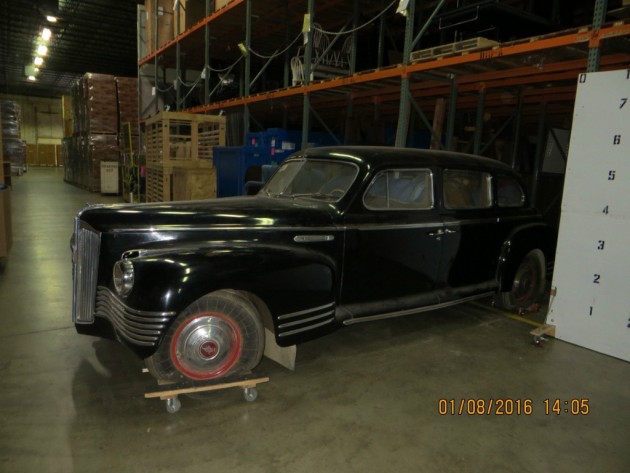
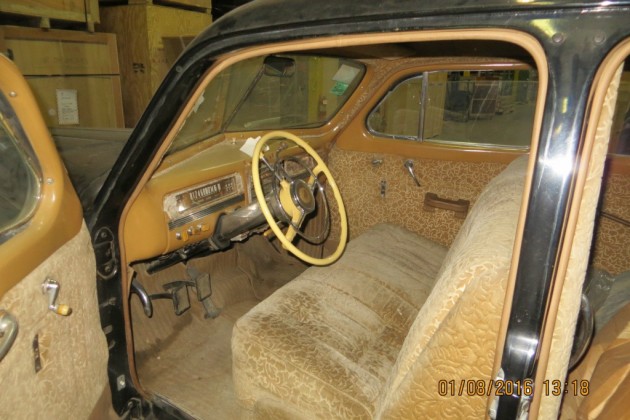


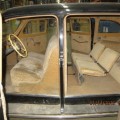
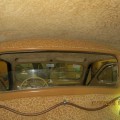
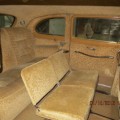
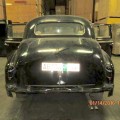


The asking price got my attention! I’ve seen one other in the U.S. — a convertible — and have seen the odd ZIL in Germany. Rare it certainly is, but $200K is a bit rich for my blood, comrades.
I have to wonder if Packard parts can be used as substitutes for maintenance. These were based on prewar Packards, after all, and I don’t know how many changes the Soviets made. Somehow, I’m thinking the local Auto Zone might just throw up their hands in frustration if you wanted to get tune-up items.
If I were a zillionaire, I’d be hot on the trail! Would love to feed those fantasies of parking this next to a ZIM, a Hong Qi and, perhaps a Moskvich….
Agree RayT. Yes, a lot like a 1942 Packard super eight. A real boat. The addition of the “red” wheels is appropriate. At 200K, not the sort of conversation piece you would find in my garage.
Were these cars manufactured from the tooling of Packard.? I note a couple other comments. Curious if Packard had mfg in the Soviet Union or if at some late date they bought the tooling from Packard. If so does anyone know in what period they built them over there and for how long. I would say this is a pretty good testament to the durability of Packard
It should be crushed why would you want anything from a man so evil as Stalin ?
… And the crowd collectively rolls their eyes..
Stalin was an evil person, and I wouldn’t want to own anything associated with him, much like I wouldn’t want anything of Hitlers, but a car is a car, nothing more. A museum is a good place for such a vehicle.
Alrighty then. Can we just come to a place to talk about cars please
Oh hell yeah
Soviet flags on the front, red carpet to role out the back doors, loud speakers belting out Russian anthem, driver in uniform with ak47
Sign me up.
Oh yeah, we won the cold war
Thankfully we all won the Cold War.
Bernie might be interested in this car. The new presidential limousine. Feel the Bern yet Hil?
Hay what
The Bern has answers
The Donald
Don’t worry your ignorant little stupid American head I have money and you don’t. I can buy the answers and solutions. Just cut my taxes and all will be well. Oh and when me and my pals pay less than $5.00 an hour without a minimum wage there will be so many jobs you can have two.
Make America great.
I don’t think the Russians used any tooling from the Packard company. They were just good copycats and maybe got ahold of an American car and “reverse engineered’ it.
PACKARD stopped production of the classic Packard in 1957. Later PACKARDS were Studebakers with Packard name plates. Packard sold the production equipment to the USSR. I believe that the soviets started producing look alike ZILs. Below isa photo of a Soviet car from American design.
NO NO NO NO!!!!
Packard did not sell or give anything to the soviets! As I mentioned earlier in this thread, the ZIS 110 & 115 limousines closely resemble the Packard limo.
I’ve studied these Russian limos up close. While they do appear to have Packard & other western automotive parts (probably purchased as needed- these were made a few at a time), after measuring both versions it is clear no manufacturing equipment from the west was involved in making the ZIS, ZIL, ZIM, or GAZ cars or trucks.
Maybe the complete truth will never be known, I”ve read that Franklin Roosevelt got involved in the transfer of obsolete Packard body dies to the Russians after dealing with Stalin about it. Who knows for sure so many years later, but Bill, I respect your observation that the parts do not perfectly interchange – you certainly know more about it than I – even if I did at one time own your old Chaika!
I think it is common knowledge that Packard sold their old body dies to the Russians, I had a 1975 Gaz 13 Chaika and certain parts were a direct interchange with a mid-fifties Packard such as the front fenders, windshield and even the wheel covers were identical except for the center medallion. The inspiration for the front bumper/grill and dash board on my car was clearly Packard yet not completely identical. I undertstand the American Packard club accepts these Chaika’s for membership in their club. I no longer own my Chaika but it was one of the best built automobiles I’ve ever seen and although it looked like a bloated Detroit barge, it handled like a fine European sports sedan.
First, oops! I didn’t mean to “report” anything, I don’t have any problem with your comment. Except, that is, to say that I’ve seen the “common knowledge” debunked a few times, and that I’ve never seen a claim that the Chaika was made with Packard tooling. Did you actually use Packard parts on a Chaika? The resemblance in front is obvious, but I don’t think that means they got tooling from Packard. And of course, our relationship with the USSR was very different in 1956 than it was in 1942, so Studebaker-Packard, then being run by Curtiss-Wright, a major defense contractor, wasn’t likely to be selling tooling to the Russians in the fifties.
I would be a rolling reenactor
Just think, a war that’s all cloak and dagger.
Trench coats, dark sun glasses, briefcases with top secret.
Get Smart, James Bond.
Moneypenny, shhh
I know nothing!
A cool artifact, a piece of history, even if it did originate in Soviet Russia. It should be in a museum.
A few years ago I was trading American license plates for European plates with a kid in Germany. He sent me a set of Hitler Youth plates from Germany. In Germany it is against the law to own them. In the US they are just another collectible oddity with no real value other than curiosity.
Even though Hitler was probably the most evil person to live in modern times, these plates are purely artifacts, nothing more, nothing less. To me it is important for future generations to remember the level of depravity that mankind is capable of to prevent such an event from ever happening again. Artifacts from those times are important to preserve to remind us of what happened.
If there is a Cold War museum somewhere, this will be a perfect addition to a collection.
I’m afraid everything Nazi Is Considered racest No mater what the context.
I would just assume to leave it that way. My Jewish savior said to love everyone. That is the most important message any religion can give.
Communist rulers could be just as bad, but we don’t consider them in the same category.
If your logic holds true, then we should round up and crush all of the VW’s in the world. Remember, the People’s Car?
If the VW on the front was a Swastika I would say yes.
Find anything with that symbol that’s acceptable.
My comments related to the Hitler youth.
A friend went to Adalf Hitler high. He didn’t brag about this.
Oh and why do you think these things were outlawed in Germany.
Wasn’t bragging. These plates don’t have a Swastika anywhere on them. They have two letters that are the designation. Just making an example that sometimes items that were used for very unsavory purposes turn into historical artifacts, just like this car has. Just for the record the arrival of those plates was a complete surprise to me. I did not ask for them had no idea what they were until it was explained after getting them. And no, they are not on display anywhere. However they could be used as part of a historical exhibit at sometime to help illustrate just how much Hitler ingrained his madness on the German people during his reign. We had family who died in the holocaust, and now some people try to deny that it happened at all. Just like the survivors who made no attempt to hide the serial numbered NAZI tattoos, because society needs to remember what happened, so that hopefully it never happens again.
No problem Van. I think we just had a misunderstanding. Thanks for being sincere and gracious.
There is a rumor that Packard sold the dies to the senior car line to the Russians during the war. It is also rumored that the dies were scrapped for the war effort. The absolute fact is the dies were gone at the end of the war. The Russians most likely just reverse engineered a car. They did it with the B-29 bomber and Baldwin diesel locomotives. Probably many other things we had and they did not.
http://www.coldwar.org/museum/museum_collection.asp
I too, owned a Chaika Gaz 13, mid 1970s version. I can say 100% with certainty that the front sheet metal will NOT interchange with any Packard. Same for the windshield. That said, I can tell you that the power window switches in the doors were actual Packard parts, right down to the tooling identification on the underside. The dash gauges appeared to be actual King-Seely Packard Clipper units from 1956. When Packard shut down the Detroit factory, they sent tons of parts to various scrapyards. One of them was a place called Muldaurers [don’t know if the spelling is correct], and they had these parts stored in 55 gallon barrels, so it’s safe to assume the Gaz factory simply bought the parts in the USA. Note that the Chaika’s engine air cleaner assembly is from a late 50s Mopar. Same for the Power steering mounted to the back of the generator, both were Mopar units on my Chaika.
Now about the Zis/Packard body myth: TAKE A CLOSE LOOK AT BOTH CARS, THEY ARE NOT THE SAME, close, but nothing interchanges as far as body panels. But again ZIS seems to have used some of the smaller Packard factory parts, probably buying the bits from local Packard dealers in Europe, as ZIS only made a few cars each year. The 3 ZIS cars I’ve examined all had various dashboard parts that were identical to Packard parts, even the markings & part numbers from the suppliers.
As for the comment on the Packard Club accepting the Gaz 13 cars for membership, They don’t accept any cars for membership, only people. That said, I don’t think I’ve ever seen a listing of either a Gaz 13 or ZIS 110 in the membership roster, as neither is a Packard.
I’ve spent HOURS pouring over several ZIS limousines [both 110 and 115 series cars], and I can agree that the ZIS was reverse engineered from 2 1942 Packard 180 limousines the US provided Stalin in 1942.
From where does your 100% certainty come from? It conflicts with my 100% certainty and experience. Interesting, huh!
Packard/Chaika differences – part 1: Fenders.
If you take a close look at the Chaika photo above, note the slightly pointed peak in both the fender line at the top of the fender, and the headlamp surround.
First let me mention until I retired a few years ago and sold off my inventory, I was a long-time Packard parts vendor, and I’m able to identify 99% of all post-war Packard parts simply by looking at them. Because I saw Packard parts “off the car” and unassembled, I could see differences that would not be evident once the part was on the car.
Most people [even V8 Packard owners] don’t realize there are actually 3 different sets of front fenders for the ’55 & ’56 cars: each year had a junior [Clipper] and Senior [Patrician, 400, Caribbean] line. The is no external difference between the 55 Jr & Sr fenders, but there is a difference in the parking light housing area, the hole for the senior park light wasn’t punched out for the Jr cars. [The ’55 Clippers didn’t use the same location for the park light].
The ’56 differences include the extended fender “eyebrow” on the Senior cars ONLY. Sometimes people mistakenly think the company took 1955 fenders & added the extended part above the headlights to create the ’56 Senior fenders. However if you take a close look at the very top of the fenders from the front to the back near the windshield, the ’55 is a smooth curve from the side of the fender to the hood opening. In the ’56 fender, there is a distinct ridge line all the way down the top, starting about 6″ after the leading edge of the fender. This ridge is on both the Jr & Sr fender variations. The Chaika has no ridge, so we can check off the 1956 Packard fenders [both versions] as not used on Chaikas.
Looking at the photo again, there is a chrome strip running horizontal from the base of the headlight area, all the way down the side of the fender. This strip is actually stainless steel, about 1.5 inches high and about 1/4 thick. The side of the fender along this area [front to rear] is flat. The trim strip is applied to a flat area.
The Packards all have a hidden change in profile where the fender juts out almost 2 inches, from the base of the headlight area all the way to the door. By the time the fender meets the door, the ridge has disappeared. The fender is actually made up of 2 steel panels welded together along this seam line. This line is covered up by a large chrome trim strip.
As you can see from the photo, the Chaika fender is flat in this area, all the way down to the door area. As part of this confusion, there is another trim piece on the Chaika that follows the general curve of the wheel opening, but again this is a flat piece of stainless steel, used to outline the wheel opening. The large [but well hidden] bump-out of the fenders is almost impossible to notice without removing the long trim pieces on the Packard cars.
From these 2 differences, its easy to see that the Chaika fenders are DAMN CLOSE to the Packard versions, but they are not Packard parts, nor did they use the tooling.
Because they are so close in appearance, I would love to see someone try to install a fender from a Chaika to a Packard, & vice-versa!
Thank you – my information was apparently wrong.
Considering the “forever lasting” myth about the Packard & ZIS using the same dies, and the fact that there are REAL Packard parts on the ZIS, ZIL and Chaika cars, it’s easy to look at the Chaika and believe they are one & the same.
Because I was a Packard parts vendor, & owning the Chaika for a short time, I had to do the hands on research to know what parts were real Packard. I bought the Chaika thru a friend in England right after the fall of the iron curtain. It was a 1975. Problem was in trying to bring it into the USA, there was little possibility of bringing it into the USA because it met NO DOT or EPA requirements, nor were any parts listed as accepted by the SAE. This meant I would have had to have detailed engineering studies on parts like brake & suspension, lighting, to show they met [or didn’t meet] the US requirements. So I consigned it to another classic car dealer in London, and they sold it for me.
I saw more MOPAR parts on the Chaika than Packard. Taking a good look at the hard plastic heater box on the firewall of the Chaika, I noted it appeared identical to the ’57 & newer MOPAR heater boxes. A friend in England with a vintage Plymouth allowed me to check his heater box, and I found a raised Penta-star emblem cast in the plastic housing. On the Chaika I noted that at that location it was clear something had been sanded off! I suspect the windshield, and the vent glass parts are all MOPAR.
Gaz only made a little over 3,000 type 13 Chaikas, and I assume the engineers decided it was cheaper to buy existing parts rather than create expensive tooling. The British were known for low-volume auto companies, and these often used “off the shelf” parts made by others.
And Brakeservo — Your Rolls-Royce & Bentley information has been spot on so far, It’s clear you know them very well. While I have owned around 300 Packards since 1966, I’ve only had about 30 PMC cars.
Part 2 -windshield.
Compared to the front fenders, this is easy to explain. Look at the photo above showing the windshield post. It’s angled like the ’57 thru about ’64 Chrysler products. The Packard windshield post is vertical.
My Chaika also came out of England but I imported it in 2005. Had formerly been the official transport of the last Soviet Premier of Lithuania and smuggled to UK in 1989 and then restored. I sold it at Barrett-Jackson in 2006 to Nancy LeMay, it is now part of the LeMay’s family’s private collection in Spanaway, Washington, not the museum. Back in the 1970s I saw a Chaika parked on Victory Blvd in Burbank California outside a garage that specialized in Mercedes, BMW and Porsche – so somehow someone got one imported back then. It’s been the only Chaika apart from my own that I’ve ever seen on an American street or highway. The Peterson Museum in L.A. has a convertible I’ve seen. But I’ve always been mystified by the Chaika I saw in Burbank. Perhaps it was a diplomat’s car.
Just one more note – I was living in Portland, Oregon when I imported my Chaika. Portland has a sizable population of people from eastern Europe such as Russia, Ukraine, etc. Driving the Chaika through those ethnic neighborhoods always caused quite a bit of attention – and not favorable either! I stopped doing it.
In doing additional research comparing the Chaika’s windshield & vent window to various MOPAR cars, I think the windshield might be from DeSoto & Chrysler, but not the door or vent window. The windshield frame does have that slight dogleg bend at the upper end, but it’s not the same vent window. The Chrysler’s vent window is much narrower. [See photo]
Although not that familiar with American cars, I recognized the “treadlevac” brake booster as a Mopar part on my Chaika.
The Treadle vac was not used by Gaz for the Chaika. It was first used by Packard, in 1952, thru 1956. It was also used by GM for only one year [I believe 1956], but replaced a year later by a GM Delco-Morain booster of similar design.
Chrysler used a different system, a large oval bellows with a shaft that pushed against the brake pedal [thru the firewall to an extension of the suspended brake pedal arm above the pivot point], thus providing the extra boost. I remembered the bellows from my Chaika, and in checking photos on line, I confirmed the Chaika used a Chrysler type unit. [see photo]
The Bendix Treadle vac was a “displacement” type of master cylinder. Unlike regular cylinders that relied on a seal around the piston cup and cylinder, on the treadle vac, the seal was made around the fat piston that was forced into a chamber holding the brake fluid. a poppet valve would close off the chamber, and as the piston entered, brake fluid was forced out to the lines.
I spoke with a retired MOPAR engineer years ago, and he said they knew of a potentially serious failure situation if even the smallest particle got trapped in the seat of the poppet valve. If that happens, the brake fluid simply leaves the chamber and goes back into the brake fluid reservoir. In effect — no brakes at all — pedal to the floor. Most Packard owners with power brakes know if this happens, you take your foot off the brake pedal, then quickly stomp down on the pedal again. Hopefully the dirt particle is dislodged, and you have brakes again.
The Delco-Morain version had another problem, instead of the stainless steel shaft of the Bendix unit, the D-M used a chrome plated steel shaft for the piston. When the chrome plating wore off, the shaft rusted, and the unit failed. This was a serious problem for the ’57 & ’58 Cadillacs.
The Chrysler version separated the brake fluid from the vacuum booster, and used a vacuum valve on the above mentioned shaft to the brake pedal arm. Pushing on the brake pedal opened up the valve, allowing vacuum to enter the bellows and provide the boost.
Once a vehicle is 25 years or older, it’s easy to ask for and get the USA waiver for antique cars, so you don’t need to conform to SAE, DOT, or EPA requirements. Your car, a 1975, was 30 years old when you brought it in during 2005.
What color was your Chaika? Did it have a division window or not? My car was black with a bland black & silver/gray interior, and no division window. I have photos of it somewhere, and I think they might include the British number plate. Would be interesting if your car and mine ended up being the same car!
In 1997 A friend in Germany and I drove his Tatra T2-603 to the 100th anniversary of Tatra, and we also went into the former DDR. Many people upon seeing the car coming down the road, turned away from us. The Tatra 603 cars were the favorite choice of the Stasi, AKA The secret Police. At that time the old DDR was still very evident, everything was dismal and in great decay.
Many of the wooden houses in the rural areas appeared to be painted black. We found out that because paint was impossible to buy, people resorted to painting their houses with used motor oil to prevent rot. However, when an oil painted house caught fire, it was impossible to put out the fire!
Brakeservo — you are welcome to contact me at my email, it’s my name as shown here, no spaces, and it’s @aol.com.
You can see photos of my Chaika here –
http://www.barrett-jackson.com/Archive/Event/Item/1974-GAZ-CHAIKA-MODEL-13-RUSSIAN-LIMO-15588
This is from Barrett-Jackson’s website when they sold the car in 2006 to Nancy LeMay. She flew from Washington (in her private jet) just to bid on this one car.
Unfortunately the auction company blanked out the license plates, I’ve got some photos, somewhere though that show the registration number.
I have also owned two Tatra 603’s – absolutely the most technically fascinating cars I’ve ever owned!
Thank you Van for a well said, sensible comment!
A few years ago I was involved in an attempt to bring Dr. Ferdinand Porsche’s personal N.S.K. identity card to auction. This is the document that allowed him to work in Germany as an automobile designer when he designed the VW Beetle (or copied a Tatra design). But the major auction houses refused to accept it because there is a swastika on the reverse side. Or so they said. Others have suggested that perhaps it was in deference to the immense power of the Porsche family who may be trying to hide Dr. Porsche’s involvement with the Nazis. He is believed to have been an ‘honorary’ Colonel in the SS. My research at the time led me to believe that mere possession of this document would be illegal in both Germany and France but I think it important that the public realize the immense influence this evil regime had on all levels of German society at that time so I was deeply offended and disappointed that none of the major auction houses had the courage or integrity to offer it in an American auction on American soil.
If we forget history, we are doomed to repeat it.
https://en.wikipedia.org/wiki/Wernher_von_Braun
Most of the NASA aerospace engineers who were the movers and shakers of the American Aerospace efforts of the 1950’s 60’s and 70’s defected from Germany during and after WWII. After the war, the world incorporated German expertise and technology into our own. Much of modern technology came about because of the aerospace industry. Medical technology, information technology, communications, defense, you name it. Every thing from the microwave oven, to the wide use of plastics, which has improved medical care by leaps and bounds, to computers, to Superglue, all were developed due to the aerospace industry. Most of it would have probably would have never occurred if the US had not encouraged Germany’s brightest and best scientists to defect to America. It’s scary that anything good could come from that regime, however a lot of who we are today was shaped by those events. And I am not saying if that is good or bad, just that it happened and is part of history.
I hate to sound like a cynic, but who really encouraged the former Nazi and German scientists to emigrate to America more, America or Russia?? I’m sure these men knew what fate awaited them if the Russians had caught them first.
But Hitler is responsible for things like the VW (which I feel is the most important and influential car to emerge right after the war . . . and if VW hadn’t become the industrial powerhouse it is today, what would have become of Audi, Bentley, Bugatti, Lamborghini, Seat and Skoda?). And the Autobahn became the blueprint for our freeways as well.
As I remember it, Von Braun and company were on the run to surrender to the Americans so the Russians would not capture them.
The Germans did develop a lot of technology during the war, but so did the Allies.
Very true! Thanks for the clarification.
This would be a cool car to add to someone’s collection. Can you imagine the looks on people’s faces if one drove this to the local car shows? And no, I would not lower it, drop in an LS small block, or rat rod it…
I don’t know well it would work to drive to a car show or anywhere else for that matter – I hear that even originally they would keep stalin’ every time you started ’em!
Van, I appreciate your comments, even if off topic a bit. You didn’t start it, people trying to sound funny by bashing Bernie did.
On a lighter note
I have always wanted to take one of these Russian cars and make a hotrod
Something similar to James Taylor’s 55 chevy in Two Lane Blacktop
A flat red 55 ZIL – ish
The engine would need to be overkill, like a V8 tank engine
Cool Idea!
Dave Holls, a former VP of styling for GM, did a wonderful expose on this myth, originally published in the Classic Car Club of America’s magazine, showing the clear differences between the two cars.
Yes, America did provide massive amounts of material assistance to the Russians up until the end of WW2, however when it came to vehicles, only complete cars & trucks, along with the spare parts needed to keep ’em running, arrived in Russia.
I will look for the link to Dave Holls story & list it here for everyone.